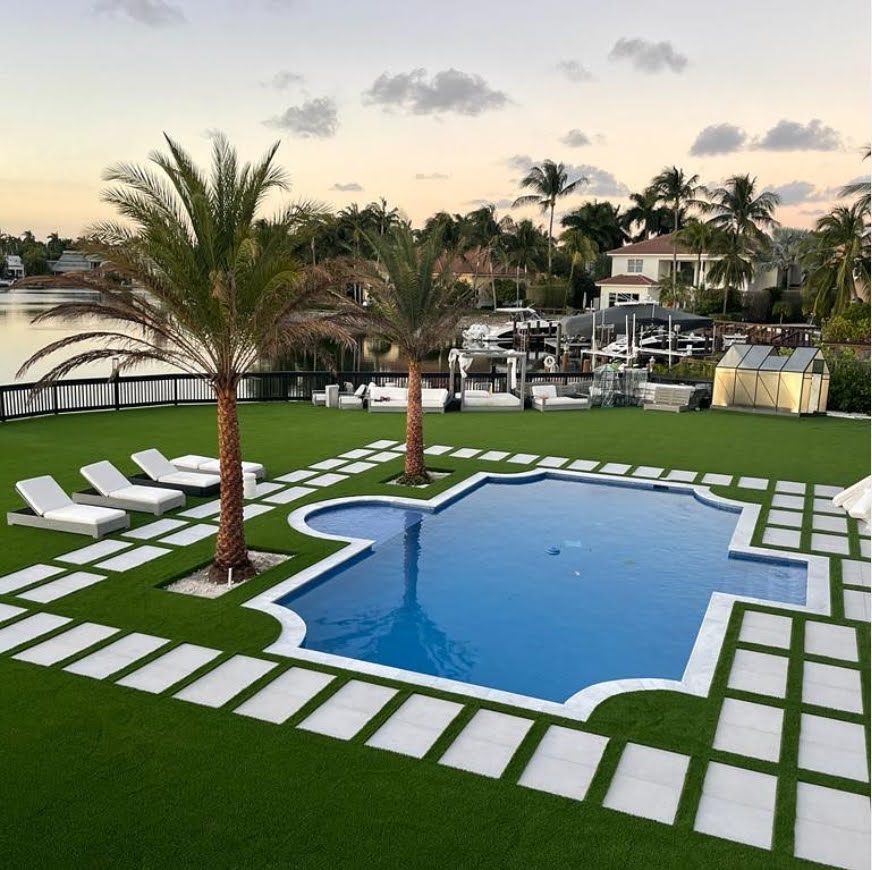What to Know Before Installing Fake Grass
1. Understanding the Types of Fake Grass: Before installing fake grass, it’s crucial to understand the different types available. Synthetic turf comes in various forms, including polyethylene, polypropylene, and nylon. Polyethylene grass is soft and realistic, ideal for residential lawns and play areas. Polypropylene is more affordable but less durable, making it suitable for decorative purposes rather than high-traffic areas. Nylon, the most durable option, can withstand heavy use and high temperatures, but it’s often the most expensive. Knowing the differences can help you choose the right type for your specific needs and budget.
2. Preparing the Installation Site: Proper site preparation is essential for a successful fake grass installation. This involves removing any existing grass, weeds, and debris from the area. The ground must be leveled and compacted to create a stable base. Installing a weed barrier fabric is recommended to prevent weed growth through the artificial turf. Additionally, a layer of crushed stone or gravel is often added to improve drainage. Ensuring the site is well-prepared will enhance the longevity and performance of your synthetic lawn.
3. Considering Drainage and Irrigation: While fake grass doesn’t require watering like natural grass, good drainage is still important to prevent water buildup. Check the drainage capabilities of the synthetic turf you choose, and ensure the installation includes proper grading and a drainage system. This might involve creating a slight slope or installing perforated pipes beneath the turf. Although fake grass eliminates the need for regular irrigation, occasional rinsing can help keep it clean, especially in areas with pets or heavy foot traffic.
4. Maintenance and Longevity: One of the main benefits of fake grass is its low maintenance requirements. However, it’s not completely maintenance-free. Regular brushing and infill replacement help maintain the grass’s appearance and prevent matting. Debris such as leaves and dirt should be removed periodically to keep the surface clean. If you have pets, clean up waste promptly and rinse the area to prevent odors. Understanding the maintenance needs of your artificial lawn will help you keep it looking great for years to come.
5. Environmental and Safety Considerations: Fake grass offers several environmental benefits, such as reduced water usage and no need for pesticides or fertilizers. However, it’s important to consider the materials used in the turf, as some can contain harmful chemicals. Look for products that are lead-free and made from non-toxic materials. Additionally, consider the impact of heat, as artificial grass can get hotter than natural grass, potentially posing a safety risk, especially for children and pets. Opt for products with cooling technology or consider installing shade structures to mitigate this issue.
By understanding the different types of fake grass, preparing the installation site properly, considering drainage and maintenance, and being aware of environmental and safety factors, you can make an informed decision and enjoy the benefits of a beautiful, low-maintenance lawn.
4714 Cypress Tree Dr, Tampa, FL 33624, USA
(813) 212-7160
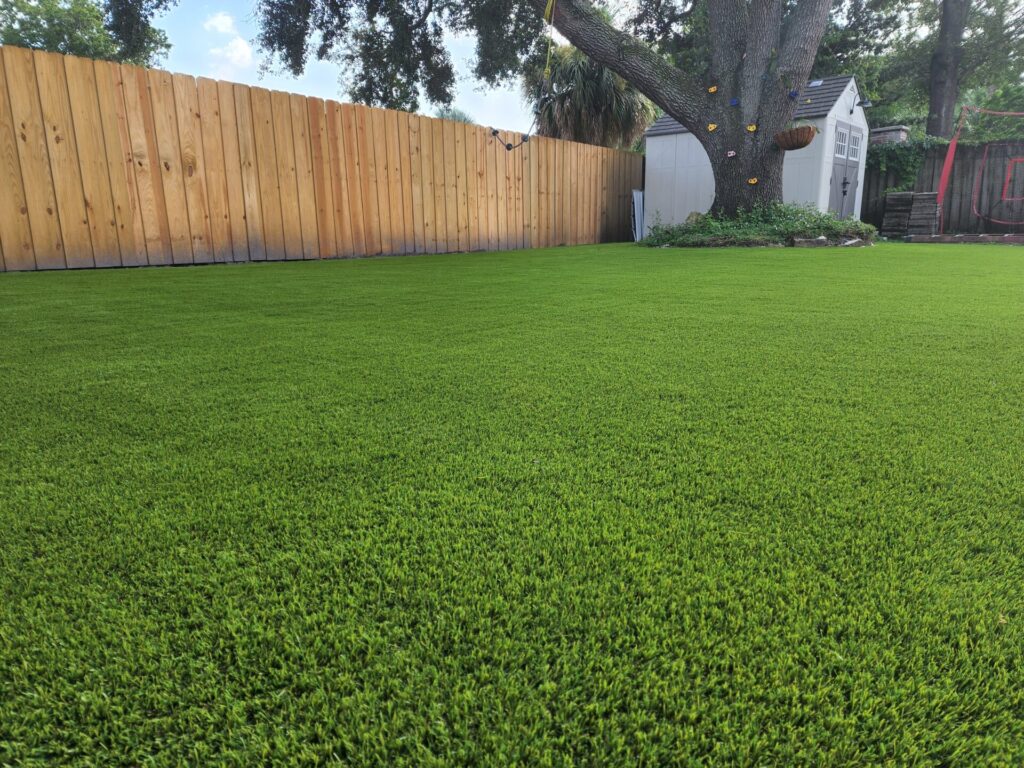
Why Proper Turf Installation is Crucial for Lasting Results
In recent years, artificial turf has become a popular choice for homeowners, sports facilities, and commercial properties due to its low maintenance and year-round green appearance. However, the key to reaping these benefits lies in ensuring that the turf installation is done correctly. Proper installation is the foundation for long-lasting and visually appealing turf that can withstand heavy use and varying weather conditions. Here are five reasons why getting turf installation done correctly is crucial for long-lasting results.
1. Ensures Proper Drainage
One of the most critical aspects of turf installation is ensuring proper drainage. When artificial turf is installed correctly, it includes a well-designed drainage system that prevents water from pooling on the surface. Poor drainage can lead to waterlogged turf, promoting the growth of mold and mildew, which can damage the turf and create an unpleasant odor. Proper drainage helps maintain the integrity of the turf, ensuring it stays dry, clean, and usable even after heavy rain.
2. Enhances Durability and Longevity
Properly installed turf is more durable and has a longer lifespan compared to turf that is poorly installed. The installation process involves preparing the ground, ensuring a smooth and even surface, and securing the turf with the appropriate materials. This meticulous approach prevents the turf from shifting, wrinkling, or tearing over time. By investing in professional installation, you ensure that your turf can withstand heavy foot traffic, intense sports activities, and the wear and tear of everyday use.
3. Maintains Aesthetic Appeal
The visual appeal of artificial grass is one of its primary advantages, and proper installation is key to maintaining this appeal. When turf is installed correctly, it looks natural and uniform, enhancing the overall appearance of your property. Uneven installation, visible seams, or poorly secured edges can detract from the turf’s aesthetic, making it look artificial and unkempt. A professional installation ensures a seamless and polished look that adds value and beauty to your landscape.
4. Prevents Damage and Costly Repairs
Improper installation can lead to various issues that may require costly repairs down the line. Issues such as turf displacement, infill erosion, and base material breakdown can occur if the installation is not done properly. These problems not only affect the functionality and appearance of the turf but also incur additional expenses for repairs and maintenance. By ensuring that the installation is done correctly from the start, you can avoid these issues and save money in the long run.
5. Maximizes Safety
Safety is a paramount concern, especially in areas where children play or athletes train. Proper synthetic turf ensures a safe playing surface by providing adequate cushioning and traction. The installation process includes adding an appropriate infill material that supports the turf fibers and provides a shock-absorbing layer. This reduces the risk of injuries caused by falls or slips, making the turf a safer option for recreational and sports activities.
In conclusion, getting turf installation done correctly is crucial for achieving long-lasting and satisfactory results. Proper installation ensures efficient drainage, enhances durability, maintains aesthetic appeal, prevents damage, and maximizes safety. By investing in professional installation, you can enjoy the many benefits of artificial turf for years to come without the hassle of frequent repairs and maintenance.
4714 Cypress Tree Dr, Tampa, FL 33624, USA
(813) 212-7160
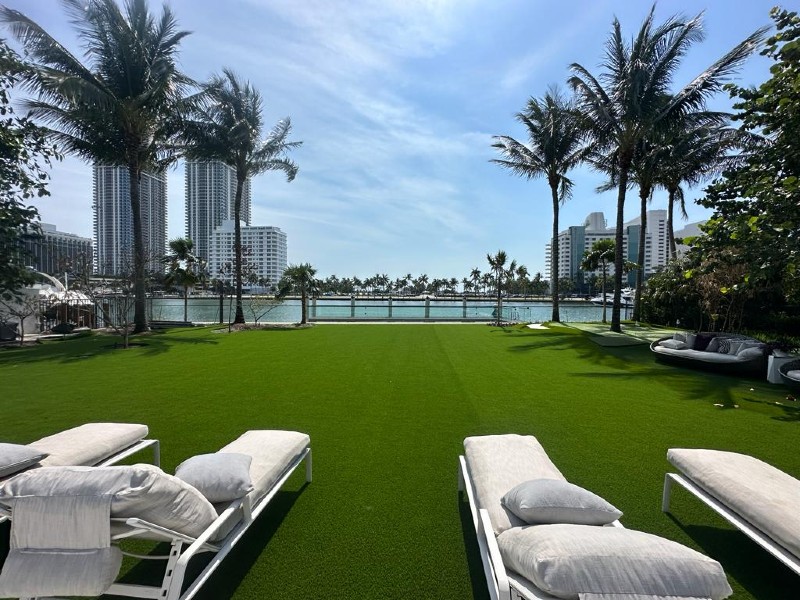
Why a Good Base is Crucial for a Successful Installation
A correct base is crucial for artificial turf installation because it provides the foundation for durability and performance. The turf can suffer from uneven surfaces, poor drainage, and instability without a well-prepared base. These issues affect the artificial grass’s aesthetic appeal and functionality, potentially leading to higher maintenance costs and a shorter lifespan. A properly constructed base ensures the artificial turf remains level, stable, and resilient under various conditions, enhancing its overall usability and longevity.
Proper drainage is another critical aspect facilitated by a correct base. Synthetic turf, unlike natural grass, does not absorb water. Therefore, without adequate drainage, water can accumulate on the surface, leading to puddles, mud, and even mold growth. A well-prepared base typically includes layers of crushed stone or gravel that allow water to flow through and drain away from the surface efficiently. This helps maintain a dry and usable surface, regardless of weather conditions, which is particularly important for sports fields and recreational areas where consistent playability is required.
Additionally, a correct base provides stability and support, which is essential for the safety of those using the artificial turf. An uneven or poorly constructed base can lead to tripping hazards, impacting the safety of athletes and other users. Ensuring that the base is level and compacted correctly reduces the risk of injuries caused by an unstable surface. This stability also contributes to the overall performance of the turf, providing a consistent playing surface that meets the standards required for various sports and activities.
The longevity of artificial grass is directly linked to the quality of its base. A well-constructed base prevents shifting and settling over time, which can cause the turf to become uneven and require frequent repairs or replacement. Investing in a proper base during the initial installation minimizes the need for future maintenance, resulting in cost savings over the long term. This makes the artificial turf more sustainable and economically viable, as it can withstand heavy usage and adverse weather conditions without significant degradation.
4714 Cypress Tree Dr, Tampa, FL 33624, USA
(813) 212-7160
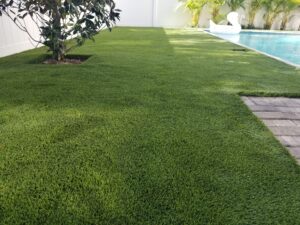
How long does Synthetic turf last in Tropical Climates
The longevity of artificial turf in tropical climates depends on several factors, including the quality of the turf, installation methods, and maintenance practices. However, high-quality synthetic turf generally lasts between 10 to 15 years in tropical climates. Here’s a closer look at what influences the lifespan of turf in these conditions:
1. Quality of the Turf
- Materials: Turf made from high-quality materials like polyethylene or nylon is more durable and resistant to wear and tear.
- UV Stabilization: Turf with UV stabilizers resists fading and degradation from intense sunlight, which is common in tropical climates.
2. Installation
- Proper Base Preparation: A well-prepared base with good drainage prevents waterlogging and ensures the turf remains stable.
- Professional Installation: Proper installation techniques, including secure seams and adequate infill, contribute to the longevity of the turf.
3. Maintenance
- Regular Cleaning: Regularly removing debris and rinsing the turf prevents mold and mildew growth, which can be more prevalent in humid, tropical environments.
- Brushing: Periodic brushing helps maintain the upright position of the fibers and keeps the turf looking natural.
- Infill Replacement: Occasionally adding or redistributing infill helps maintain the turf’s cushioning and appearance.
4. Climate Factors
- Heat and Humidity: High temperatures and humidity levels can accelerate the breakdown of artificial grass materials. Choosing turf specifically designed to withstand heat can mitigate this effect.
- Rainfall: Tropical climates often experience heavy rains. Ensuring proper drainage during installation prevents water accumulation that can damage the turf.
5. Usage
- Foot Traffic: Areas with heavy foot traffic may see more wear and tear, reducing the lifespan of the turf. Choosing a higher-grade turf designed for such conditions can extend its life.
- Pets: If pets frequently use the turf, ensuring regular cleaning and choosing pet-friendly options can help maintain its condition.
Conclusion
In tropical climates, the lifespan of synthetic turf can range from 10 to 15 years, provided it is of high quality, properly installed, and well-maintained. Investing in UV-resistant materials, ensuring proper drainage, and following a consistent maintenance routine will help maximize the durability and appearance of your synthetic lawn in these challenging environmental conditions.
4714 Cypress Tree Dr, Tampa, FL 33624, USA
(813) 212-7160
Different Reasons to Get Artificial Grass Installed
Artificial grass has become increasingly popular in recent years, and for good reason. Here are several compelling reasons to consider installing synthetic turf in your outdoor space.
1. Low Maintenance
- No Mowing: Artificial grass doesn’t grow, so there’s no need to mow your lawn regularly.
- No Watering: Unlike natural grass, synthetic turf doesn’t require watering, which saves both time and water.
- Weed-Free: A proper installation includes a weed barrier, reducing the need for weed control.
2. Cost Savings
- Lower Water Bills: Since artificial grass doesn’t need watering, you can save significantly on your water bill.
- Reduced Maintenance Costs: No need to buy lawnmowers, fertilizers, or pesticides, leading to lower overall maintenance costs.
3. Durability and Longevity
- High Traffic Tolerance: Synthetic turf can withstand heavy use without wearing out, making it ideal for homes with children and pets.
- Weather Resistant: Artificial grass stays green and lush in all weather conditions, from scorching summers to harsh winters.
4. Aesthetics
- Year-Round Green: Enjoy a beautiful, green lawn throughout the year without the seasonal browning or bare patches of natural grass.
- Customizable: Artificial grass comes in various shades and lengths, allowing you to choose the perfect look for your yard.
5. Environmental Benefits
- Water Conservation: Reducing the need for irrigation helps conserve water, an increasingly precious resource.
- No Pesticides or Fertilizers: Synthetic turf doesn’t require harmful chemicals, making it safer for the environment.
6. Safety
- Non-Toxic: High-quality artificial grass is non-toxic and safe for children and pets.
- Even Surface: The even, soft surface of synthetic turf reduces the risk of trips and falls, making it safer for play areas.
7. Versatility
- Variety of Uses: Ideal for lawns, rooftops, balconies, patios, playgrounds, and sports fields.
- Indoor Applications: Can be used indoors for gyms, playrooms, and other recreational spaces.
8. Pet-Friendly
- Durable for Pets: Artificial grass is resistant to digging and rough play, making it perfect for pet owners.
- Easy Cleanup: Waste can be easily removed, and the area can be rinsed clean, keeping your lawn looking pristine.
9. Allergen-Free
- No Pollen: Artificial grass doesn’t produce pollen, making it a great option for those with grass allergies.
- Dust Control: Regular rinsing can keep dust levels low, contributing to a cleaner outdoor environment.
10. Increased Property Value
- Curb Appeal: A well-maintained synthetic lawn can enhance the overall appearance of your property, potentially increasing its value.
- Attractive to Buyers: Prospective buyers often appreciate the low-maintenance aspect of artificial grass, which can be a selling point.
Conclusion
Artificial grass offers numerous benefits, from low maintenance and cost savings to environmental friendliness and aesthetic appeal. Whether you’re looking to enhance your backyard, create a safe play area for children, or save on water and maintenance costs, synthetic turf is a versatile and practical solution. Consider these reasons when deciding if artificial grass is the right choice for your home or business.
4714 Cypress Tree Dr, Tampa, FL 33624, USA
(813) 212-7160

How to Take Care of Your Synthetic Turf
Synthetic turf is an excellent choice for those who want a green, low-maintenance lawn all year round. However, to keep it looking its best, some routine care is required. Here are some practical tips to ensure your synthetic turf remains lush and vibrant for years to come.
1. Routine Cleaning
- Remove Debris: Regularly remove leaves, branches, and other debris that may accumulate on your synthetic turf. Use a leaf blower, garden vacuum, or a rake designed for artificial grass.
- Rinse Regularly: Periodically rinse the turf with water to remove dust, pollen, and small debris. This helps keep the grass clean and fresh.
2. Brush the Grass Fibers
- Maintain the Blades: Use a stiff brush to periodically brush the grass blades against the grain. This helps keep the fibers standing upright and looking natural.
- Use the Right Brush: Avoid metal brushes. Instead, use brushes with synthetic bristles to prevent damage to the turf.
3. Handle Stains Promptly
- Immediate Action: Clean up spills as soon as they happen to prevent stains from setting in. A mixture of water and mild detergent can handle most stains.
- Stubborn Stains: For tougher stains like oil or grease, use a small amount of mineral spirits on a cloth and gently blot the area.
4. Pet-Friendly Maintenance
- Remove Waste Quickly: Clean up solid pet waste promptly and rinse the area with water.
- Control Odors: To neutralize odors, mix equal parts water and vinegar and spray the affected area.
5. Weed Prevention
- Inspect Regularly: Check the edges of your turf regularly for any signs of weed growth.
- Use a Weed Barrier: Ensure a proper weed barrier is installed beneath the turf to minimize weed growth.
6. Preventing Damage from Heavy Use
- Distribute Weight: Avoid leaving heavy objects on your astroturf for extended periods. Use pads or mats under heavy furniture to distribute weight evenly.
- Rotate Items: Move heavy furniture around periodically to prevent wear and tear in one spot.
7. Protect from Heat
- Avoid Direct Flames: Keep barbecues, fire pits, and other heat sources away from your artificial turf to prevent melting.
- Provide Shade: In extremely hot climates, consider providing some shade to protect the turf from excessive heat and UV exposure.
8. Seasonal Care
- Winter Maintenance: In snowy areas, avoid using metal shovels or sharp tools to remove snow. Opt for a plastic shovel or broom instead.
- Spring and Summer: Increase the frequency of brushing and rinsing to manage the higher levels of pollen and dust.
Conclusion
Maintaining your synthetic turf is straightforward and can significantly extend its lifespan. By following these simple steps, you can keep your artificial grass looking vibrant and fresh, providing you with a beautiful, hassle-free lawn all year round.
Investing a little time and effort into regular maintenance will ensure that your synthetic turf continues to be a source of pride and enjoyment for many years to come.
4714 Cypress Tree Dr, Tampa, FL 33624, USA
(813) 212-7160

The Benefits of Installing Artificial Turf for Your Home
Artificial turf has become an increasingly popular choice for homeowners looking to enhance their outdoor spaces. Whether for a lawn, garden, patio, or other landscaping areas, artificial turf offers numerous advantages over natural grass. Here are some of the key benefits of installing artificial turf at home.
1. Low Maintenance
One of the biggest advantages of artificial turf is its low maintenance requirements. Unlike natural grass, which needs regular mowing, watering, fertilizing, and pest control, artificial turf remains green and lush with minimal effort. Homeowners can save time, money, and effort by eliminating the need for these routine maintenance tasks.
2. Water Conservation
In regions where water is a precious resource, artificial turf provides a significant benefit by conserving water. Natural grass lawns require substantial amounts of water to stay healthy, especially during dry seasons. Artificial turf, on the other hand, does not need watering, which can lead to significant reductions in water usage and lower utility bills.
3. Durability and Longevity
Artificial grass is designed to withstand heavy foot traffic and various weather conditions. It is made from durable materials that resist fading, tearing, and flattening, ensuring a long lifespan. This durability makes it an excellent choice for areas that receive frequent use, such as backyards, play areas, and pet zones.
4. All-Weather Usability
Artificial turf provides a usable outdoor space regardless of the weather. It does not get muddy or waterlogged after rain, and it remains green and functional during droughts. This all-weather usability makes it ideal for homeowners who want a consistently attractive and usable lawn throughout the year.
5. Safe for Children and Pets
Artificial turf is a safe and hygienic option for families with children and pets. It provides a soft, cushioned surface that reduces the risk of injuries from falls. Many artificial turf products are also designed with antimicrobial properties to prevent the growth of bacteria and reduce odors. Additionally, it does not attract pests like insects and rodents, creating a safer environment for kids and pets to play.
6. Aesthetic Appeal
Artificial turf has come a long way in terms of appearance and texture. Modern artificial turf products are designed to look and feel like natural grass, providing a visually appealing and realistic lawn. It stays green and lush year-round, enhancing the curb appeal of your home without the hassle of seasonal maintenance.
7. Cost-Effective
While the initial cost of installing synthetic turf may be higher than that of natural grass, the long-term savings are substantial. Homeowners can save on water bills, lawn care products, and professional landscaping services. Over time, these savings can offset the initial investment, making artificial turf a cost-effective option in the long run.
8. Eco-Friendly Options
Many artificial turf products are made from recycled materials and are recyclable at the end of their lifespan. By choosing eco-friendly artificial turf, homeowners can reduce their environmental footprint. Additionally, artificial turf eliminates the need for chemical fertilizers and pesticides, which can be harmful to the environment.
9. Versatility
Artificial turf can be used in a variety of landscaping applications beyond traditional lawns. It can be installed on patios, rooftops, balconies, and even indoor areas to create a green, natural look. Its versatility makes it a great option for creative landscaping projects and areas where natural grass might not thrive.
10. Enhanced Property Value
A well-maintained and attractive lawn can enhance the overall value of your property. Artificial turf provides a lush, green lawn that remains beautiful year-round, boosting curb appeal and potentially increasing property value. For homeowners looking to sell their property, artificial turf can be a selling point that attracts potential buyers.
Conclusion
Artificial turf offers a range of benefits for homeowners, from low maintenance and water conservation to durability and aesthetic appeal. Its all-weather usability, safety features, cost-effectiveness, and eco-friendly options make it an excellent choice for various landscaping applications. By installing artificial turf, homeowners can enjoy a beautiful, hassle-free lawn that enhances the overall appeal and functionality of their outdoor spaces.
4714 Cypress Tree Dr, Tampa, FL 33624, USA
(813) 212-7160

Consider Synthetic Grass for Your Kids’ Playground
Creating a safe, fun, and low-maintenance play area for your children is a top priority for any parent. When it comes to choosing the best surface for your kids’ playground, synthetic grass offers numerous advantages over natural grass and other traditional surfaces. Here are compelling reasons to consider synthetic grass for your children’s play area.
1. Safety First
Safety is paramount when it comes to playgrounds. Synthetic grass provides a soft, cushioned surface that reduces the risk of injuries from falls. Many synthetic grass products are designed with added padding or shock-absorbent layers that comply with safety standards for playgrounds. This extra layer of protection ensures a safer play environment for children.
2. All-Weather Playability
Synthetic grass offers consistent playability regardless of the weather. Natural grass can become muddy and slippery in wet conditions, posing a safety hazard. With synthetic grass, rainwater drains quickly, preventing puddles and keeping the surface dry and safe for play shortly after a rain shower. Additionally, it does not get too hot in the sun, thanks to modern heat-resistant materials, making it comfortable for children to play on even on sunny days.
3. Low Maintenance
Maintaining a natural grass playground can be time-consuming and expensive. It requires regular mowing, watering, fertilizing, and pest control. Synthetic turf eliminates these chores, saving time and money. It stays green and lush year-round without the need for watering, mowing, or chemical treatments. This means more time for you to enjoy the play area with your children rather than maintaining it.
4. Durability
Children’s play areas endure a lot of wear and tear. Synthetic grass is designed to withstand heavy foot traffic and rough play. It is made from durable materials that resist fading, tearing, and flattening, ensuring the playground remains in excellent condition for years. Unlike natural grass, it won’t develop bare spots or become patchy over time.
5. Allergen-Free
Natural grass can be a source of allergens, causing discomfort for children with allergies. Synthetic grass is hypoallergenic, providing a safe and comfortable play environment for children with sensitivities. By choosing synthetic grass, you can help reduce the risk of allergic reactions and ensure that all children can enjoy the playground without discomfort.
6. Eco-Friendly Options
Many synthetic grass products are now made with environmentally friendly materials and processes. They help conserve water by eliminating the need for irrigation and reduce the use of harmful pesticides and fertilizers. Additionally, some manufacturers offer synthetic grass made from recycled materials, further reducing its environmental impact.
7. Aesthetic Appeal
Artificial grass maintains its vibrant green color and neat appearance year-round, providing an attractive and inviting play area. It can be installed in a variety of settings and customized to fit the design of your playground. The realistic look and feel of modern synthetic grass products ensure that your play area remains beautiful and appealing to children and adults alike.
Conclusion
Synthetic grass is an excellent choice for children’s playgrounds due to its safety features, durability, low maintenance requirements, and all-weather playability. It provides a clean, allergen-free environment that is both attractive and eco-friendly. By choosing synthetic grass for your kids’ play area, you can create a fun, safe, and low-maintenance space that your children will enjoy for years to come.
4714 Cypress Tree Dr, Tampa, FL 33624, USA
(813) 212-7160
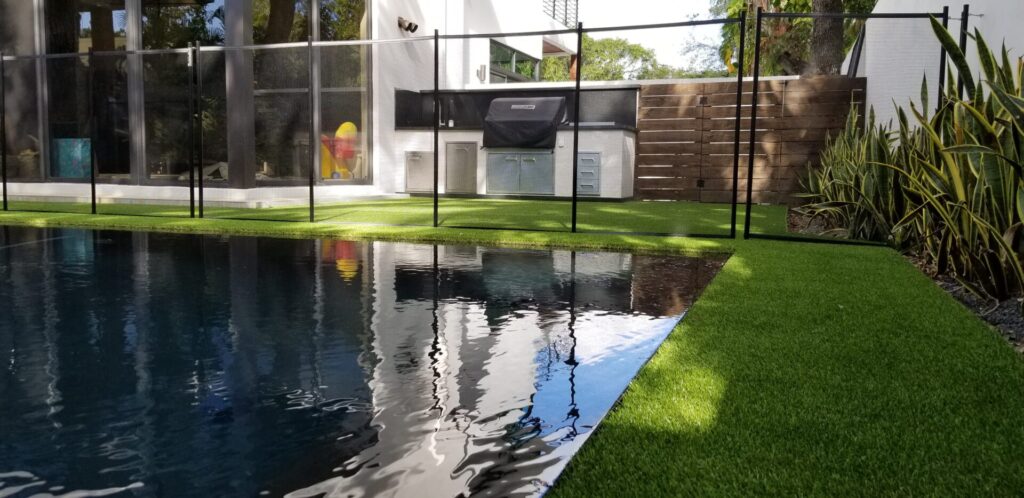
Is Synthetic Grass Safe in the Florida Heat?
Synthetic grass has gained popularity as a low-maintenance alternative to natural grass, especially in climates like Florida’s, where high temperatures and intense sunlight can make lawn care challenging. But is synthetic grass safe in the Florida heat? Let’s explore the considerations and benefits of using synthetic turf in such a warm environment.
1. Heat Resistance and Comfort
Modern Materials: High-quality synthetic grass is designed to withstand extreme temperatures. Advances in turf technology have led to the development of materials that are not only durable but also heat-resistant. These modern turfs reflect sunlight instead of absorbing it, keeping the surface cooler than older types of artificial grass.
Cooling Technologies: Some artificial turf products come with built-in cooling technologies, such as heat-reflective pigments and infill materials that absorb less heat. These features help maintain a comfortable surface temperature, even during the hottest parts of the day.
Surface Temperature Management: While synthetic grass can get warmer than natural grass, regular watering can help cool it down. A quick spray with a garden hose can reduce the temperature significantly, making it more comfortable for pets and children to play on.
2. Safety for Children and Pets
Non-Toxic Materials: Synthetic grass is made from non-toxic materials that are safe for both children and pets. It doesn’t contain harmful chemicals found in some pesticides and fertilizers used on natural lawns.
Soft Surface: The surface of synthetic grass is soft and cushioned, providing a safe play area for kids. Many types of synthetic turf have shock-absorbent underlays that further enhance safety by reducing the risk of injuries from falls.
Allergen-Free: Synthetic grass doesn’t produce pollen, making it an excellent choice for families with allergies. It also doesn’t harbor pests like ticks and fleas, which can be a concern with natural grass.
3. Durability and Maintenance
Withstands High Traffic: Synthetic grass is designed to withstand heavy foot traffic, making it ideal for homes with active families and pets. It doesn’t get worn down or develop bare spots, even with frequent use.
Low Maintenance: One of the significant advantages of synthetic grass is its low maintenance requirements. It doesn’t need watering, mowing, or fertilizing, which is especially beneficial in the Florida heat where natural grass would require constant care to stay green.
Longevity: High-quality synthetic grass can last for many years, even in harsh climates. Its durability ensures that it remains lush and green without the need for extensive upkeep, providing long-term cost savings.
4. Environmental Benefits
Water Conservation: In Florida, water conservation is crucial due to periodic droughts and high water demand. Synthetic grass eliminates the need for irrigation, helping conserve water and reduce utility bills.
No Chemical Runoff: Without the need for pesticides and fertilizers, synthetic grass reduces chemical runoff into local waterways. This contributes to a healthier environment and helps protect Florida’s natural ecosystems.
5. Aesthetic Appeal
Year-Round Greenery: Synthetic turf stays green and vibrant all year round, regardless of the weather. This consistent appearance can enhance the curb appeal of your home and provide a beautiful backdrop for outdoor activities.
Versatile Design: Synthetic grass can be tailored to fit various landscaping designs, from simple lawns to complex garden layouts. It offers flexibility in creating the backyard of your dreams without the constraints imposed by natural grass.
Conclusion
Synthetic grass is a safe and practical option for Florida’s hot climate. With modern advancements in materials and technology, it offers a comfortable, durable, and low-maintenance alternative to natural grass. Its heat-resistant properties, coupled with its safety for children and pets, make it an excellent choice for homeowners looking to create a beautiful and sustainable outdoor space.
By opting for synthetic grass, you can enjoy a lush, green lawn year-round without the hassle of constant maintenance and high water bills. Whether you’re looking to revamp your backyard, create a safe play area for kids, or design a pet-friendly garden, synthetic grass provides a versatile and eco-friendly solution that thrives in the Florida heat.
4714 Cypress Tree Dr, Tampa, FL 33624, USA
(813) 212-7160
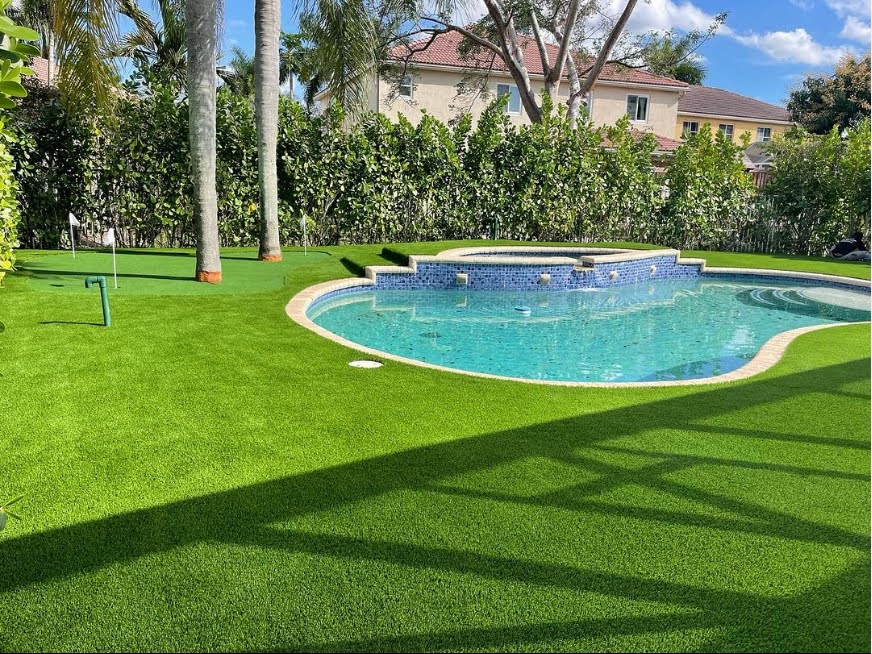
Creative Ideas for Transforming Your Backyard
Your backyard can be so much more than just a patch of grass. With a bit of creativity and planning, it can become a personal oasis, a playground, or even an extension of your living space. Whether you have a large yard or a small patio, here are some exciting ideas to transform your backyard into a place of relaxation, entertainment, and beauty.
1. Outdoor Living Room
Comfortable Seating: Create an outdoor living room by setting up comfortable seating arrangements with weather-resistant furniture. Include a mix of sofas, lounge chairs, and poufs to cater to different preferences.
Weatherproof Decor: Add outdoor rugs, cushions, and throw blankets to make the space cozy. Choose materials that can withstand the elements.
Ambiance Lighting: String lights, lanterns, and solar-powered garden lights can add a magical touch to your outdoor living room, making it perfect for evening gatherings.
2. Garden Oasis
Themed Gardens: Consider creating themed gardens, such as a tropical paradise with palm trees and exotic plants, or a Zen garden with gravel, stones, and minimalistic plantings.
Water Features: Incorporate a water feature like a pond, fountain, or waterfall. The sound of running water can be incredibly soothing and add a tranquil element to your garden.
Seating Nooks: Place benches or hammocks in shaded spots to create peaceful seating nooks where you can relax and enjoy your garden.
3. Outdoor Dining Area
Dining Set: Invest in a sturdy outdoor dining set to create a dedicated space for alfresco dining. A large table with comfortable chairs can accommodate family meals and parties.
Pergola or Gazebo: Install a pergola or gazebo to provide shade and define the dining area. Decorate it with climbing plants or curtains for added charm.
Outdoor Kitchen: If you love cooking, consider adding an outdoor kitchen with a grill, countertop, and sink. This setup makes it easier to prepare and serve meals outdoors.
4. Backyard Playground
Swing Set and Slide: Install a swing set, slide, or climbing structure to create a fun and safe playground for children.
Sandbox: Add a sandbox for endless hours of creative play. Ensure it’s covered when not in use to keep it clean.
Trampoline: A trampoline can provide great exercise and entertainment for kids and adults alike. Ensure it’s properly secured and includes a safety net.
5. Vegetable and Herb Garden
Raised Beds: Use raised beds to grow your vegetables and herbs. They are easier to manage and can be more productive than traditional garden plots.
Vertical Gardens: If space is limited, consider vertical gardening using trellises, wall planters, or stacked pots.
Garden Pathways: Create charming pathways between your garden beds using gravel, wood chips, or stepping stones.
6. Outdoor Cinema
Projector and Screen: Set up an outdoor projector and screen for movie nights under the stars. You can also use a blank wall or a large sheet as a screen.
Comfortable Seating: Arrange comfortable seating with lounge chairs, bean bags, and blankets. Add a popcorn machine or snack bar for the full cinema experience.
Ambient Lighting: Use soft, ambient lighting to create a cozy atmosphere without interfering with the movie viewing.
7. Fitness and Wellness Area
Yoga Deck: Build a wooden deck or use a flat area for a dedicated yoga and meditation space. Surround it with plants and add a water feature for tranquility.
Outdoor Gym: Set up an outdoor gym with equipment like a pull-up bar, free weights, and resistance bands. Ensure the area is shaded and has a non-slip surface.
Spa Corner: Create a spa corner with a hot tub or portable spa. Add lounge chairs and privacy screens to complete the relaxing retreat.
8. Fire Pit Area
Central Fire Pit: Install a fire pit as the focal point of your backyard. It can be built-in or portable, depending on your space and budget.
Seating Circle: Arrange seating in a circle around the fire pit. Use Adirondack chairs, benches, or large rocks for a rustic look.
Marshmallow Station: Set up a small table with marshmallows, chocolate, and graham crackers for making s’mores.
Conclusion
Your backyard has endless potential to become an extension of your home, reflecting your lifestyle and interests. Whether you want a relaxing retreat, a place for family fun, or an entertainment hub, these ideas can help you transform your outdoor space into something special. Start planning today and enjoy the benefits of a beautifully designed backyard all year round.
4714 Cypress Tree Dr, Tampa, FL 33624, USA
(813) 212-7160
